Background - Canadian military aerobatic teams
Snowbirds - HistoryCanadian military formation aerobatic teams have played a distinguished part in our military aviation history. Since the inception of the "Siskins" in the 1930's there have been many teams, all of whom have exemplified the skill and proficiency common to our Air Force pilots and ground crew. The Golden Hawks and Golden Centennaires are still remembered by many people who enjoyed their exciting aerobatic displays. These teams received world-wide recognition, and their members were proud ambassadors of the men and women of the Canadian military. The Snowbirds, while performing before millions of spectators across North America, are honoured to carry on the fine traditions established by their forerunners.
One problem has been common to Canada's aerobatic teams - the continuing struggle for existence. Teams which had been formed as a result of the perseverance and initiative of dedicated individuals slowly matured, but were all too soon disbanded; the prime reason for disbandment was normally that of expense. The year 1978 was a milestone in the history of Canada's formation teams.
Double click here to edit this text.
431 (Air Demonstration) Squadron - the beginning
The Snowbirds, who first performed in July of 1971, operated on a year to year basis for seven years, before being finally established as a permanent squadron on 1 April, 1978. The Canadian Forces Air Demonstration Team was then renamed 431 (Air Demonstration) Squadron. This was not an achievement which came easily; it resulted from the cumulative efforts of numerous individuals over the previous ten years. It was also a result of the support given to the team by members of the Canadian Forces and the public sector throughout Canada - support which is readily apparent while the Snowbirds travel across the country during the airshow season.
The Golden Centennaires
The seed for the Snowbirds was firmly planted in 1967 with the formation of the Golden Centennaires to commemorate Canada's centennial year. Ten RCAF basic jet training aircraft, CT-114 Tutors, received the gold and blue paint scheme which distinguished them as the aircraft from the RCAF formation aerobatic team. However, at the end of the 1967 season, the Centennaires were disbanded, and the aircraft were returned to the training role.
The Snowbirds are formed in 1971
Snowbirds - HistoryColonel O.B. Philp, the Commanding Officer of the Centennaires, became the Base Commander of CFB Moose Jaw, but he never forgot the team of 1967. He wanted to ensure that the traditions of aerial perfection established by teams such as the Golden Hawks and his own Golden Centennaires would not be lost. Accordingly, he established an unofficial non-aerobatic formation team in Moose Jaw in 1971. The team was made up of volunteer instructor pilots and ground crew led by Major Glen Younghusband. All of the instructors came from Two Canadian Forces Flying Training School (2CFFTS) in Moose Jaw. The team utilized Seven ex-Centennaire Tutor aircraft. Since these aircraft were already repainted white, they were readily distinguishable from the other silver-coloured aircraft of the Moose Jaw fleet. The 2CFFTS Formation Team members practised in the evenings, after completing their primary instructional duties, and performed on weekends. The new team was named the "Snowbirds" as a result of a contest held at the Base Elementary School and first flew under this name at the 1971 Saskatchewan Homecoming Airshow on the 11th of July. This performance was followed by appearances at other major airshows such as Abbotsford, BC and the CNE in Toronto, and also at military bases across Canada. During the show season which lasted from June to the end of August the team performed 27 shows. Public response indicated that the re-forming of a Canadian formation team was a popular move.
The Snowbirds are made an official unit
Major Gord Wallis became Commanding Officer and Team Lead for the 1977-78 seasons. In September 1977, the Snowbirds were finally made a permanent unit, and their official designation became the Canadian Forces Air Demonstration Team (CFADT). On April 1st, 1978, the CFADT received squadron status, and the Snowbirds became 431 (Air Demonstration) Squadron. 431 "Iroquois" Squadron, The Hatiten Ronteriios or "Warriors of the Air", had been a World War II Bomber squadron that was disbanded in 1945. It was reformed briefly in 1954 as an F-86 sabre squadron which contributed four aircraft to the "Prairie Pacific" aerobatic teams.
Under the direction of Major Tom Griffis, the Squadron Commanding Officer/Team Lead for the 1979-80 seasons, the Snowbirds performance featured an expanded nine-plane opening sequence that received popular acclaim with an estimated audience throughout North America, of over five million spectators.
The Snowbirds in the 1980s
The 1981-82 Snowbirds were under the leadership of a new Commanding Officer/Team Lead Major Mike Murphy. For the first time, the show opened and closed with nine-plane formation sequences and was performed in 1982 before a total audience of more than six million fans.
The tradition was continued in 1983-84 as Major George Hawey led the team through a total of 133 shows in the two year period. The year 1984 was special in that the team helped celebrate the 75th Anniversary of powered flight in Canada and the 60th Anniversary of the Royal Canadian Air Force.
Snowbirds - HistoryMajor D.F. (Yogi) Huyghebaert led the 1985-86 Snowbird teams through a total of 121 shows throughout North America. In 1986 several performances were flown at the Expo 86 site, and the Snowbirds were one of five military aerobatic teams to perform at the Abbotsford International Airshow. On August 9th, 1986, Major Huyghebaert was honoured to lead a historic five-plane flypast consisting of one aircraft from each of the different military demonstration teams from Europe, and North and South America.
The 1987-88 Snowbirds teams were led by Major Denis Beselt who at 30 years of age, was the youngest Snowbird Team Lead ever. A highlight of the 1988 season was the opening ceremonies of the Winter Olympic Games in Calgary, Alberta where the team's performance was witnessed by almost two billion people around the world.
The Snowbirds in the 1990s
Major Dan Dempsey of Edmonton, Alberta took over the reins of the squadron for 1989-90, with 1990 representing the Team's 20th Anniversary season. During 1990 the team flew their 1000th official air demonstration and also incorporated the use of red and white smoke at several major show sites. The 1990 team scheduled 74 displays at 53 locations. Major Bob Stephan led the 1991-92 Snowbirds through 125 shows. In addition to these scheduled performances the team performed briefly in concert with the United States Navy Blue Angels during Disney's 20th Anniversary celebrations in the fall of 1991, and flew as part of the opening ceremonies prior to the 1991 Grey Cup Game. In 1992 the Snowbirds performed for the Inuit Circumpolar Conference at Inuvik, NWT and were honoured to be official ambassadors for the Canada 125 celebrations commemorating Canada's 125th Birthday.
Top of Page
The Snowbirds perform in Mexico
Under the leadership of Major Dean Rainkie of Melville, Saskatchewan the 1993-94 Snowbirds marked some historic milestones. It was in 1993 that the team saw its first performances outside of Canada and the United States with three aerial demonstrations in Guadalajara, Mexico. In 1994 Major Rainkie led the team through 64 performances before an estimated 3.6 million spectators. The team also commemorated the 70th Anniversary of the Royal Canadian Air Force, proudly displaying a tribute to the RCAF on each aircraft.
The Snowbirds celebrate their 25th anniversary season
The 1995 season represented the 25th Anniversary of 431 (AD) Squadron. Unfortunately, the founding father of the team, Colonel O.B. Philp passed away early in 1995 and as a tribute to him the 1995 season was dedicated to his memory. Major Steve Hill, fighter pilot and veteran of the Gulf War, led the team through 145 aerial performances throughout Canada and the United States during the 1995-1996 show seasons.
Having flown as an outer wingman in 1988/89, Major Darryl Shyiak of Portage-la-Prairie (Manitoba), led the team through 130 performances before an estimated 4 million spectators during 1997/98. In 1998, Major Shyiak dedicated a new manoeuvre named after the founding father of the Snowbirds, Col O.B. Philp; called the Philp roll. During the past 28th seasons, the Snowbirds presented more than 1,575 shows before more than 85,000,000 spectators.
Major Bob Painchaud, a former solo pilot in 1992/93 and veteran CF-18 and CF-5 fighter pilot, was Team Lead for the 1999 to 2001 seasons.
Year 2000 marks busiest show season
Snowbirds - HistoryHe oversaw the presentation of the Squadron Colours at the end of the 1999 season and led the Snowbirds in 2000 through their busiest show season ever - more than 90 shows in over 70 locations across North America. Major Painchaud finished his tenure as Team Lead in October 2001, at the end of the Snowbirds' 31st show season.
Major Steve Will, a former Inner Left Wing pilot in 1989/90 and also a veteran CF-18 and CF-5 fighter pilot, assumed command of the Snowbirds in October 2001. Major Will will lead the Snowbirds through their 2002 to 2004 seasons. In their 34th season, the Snowbirds performed in more than 65 shows in over 41 locations across North America in 2004.
Celebrating 35 Years of Hearts
The Snowbirds not only celebrated "35 Years of Hearts" in 2005, but they also celebrated their 2,000th show September 17 in Reno, Nevada. This extremely significant milestone is a celebration of the tradition of excellence that the Snowbirds strive to preserve.
The 35th anniversary season was dedicated to the memory of our fellow pilot and friend, Captain Miles Selby, who died during a training accident December 10, 2004. Miles is sadly missed by the Team not only for his professionalism and skill as a pilot, but for his fine character.
As ambassadors for the Canadian Forces and Canada, the Snowbirds not only strive for aerial perfection, but they also ensure that they preserve the team's legacy of excellence in military deportment. The Snowbirds consider it a privilege to perform in communities across North America proudly representing all men and women in Canada's military, who are serving both at home and deployed on missions overseas.
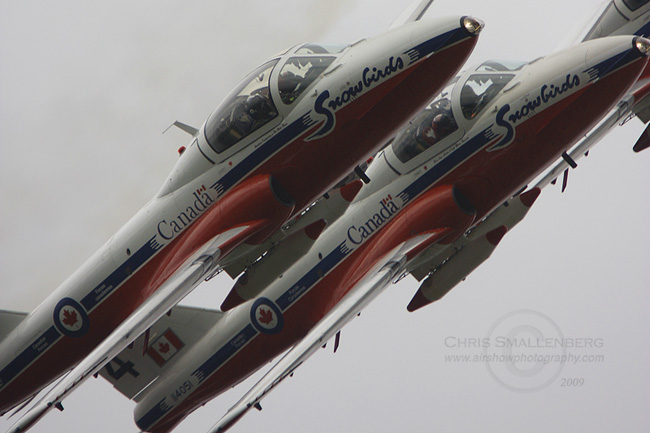
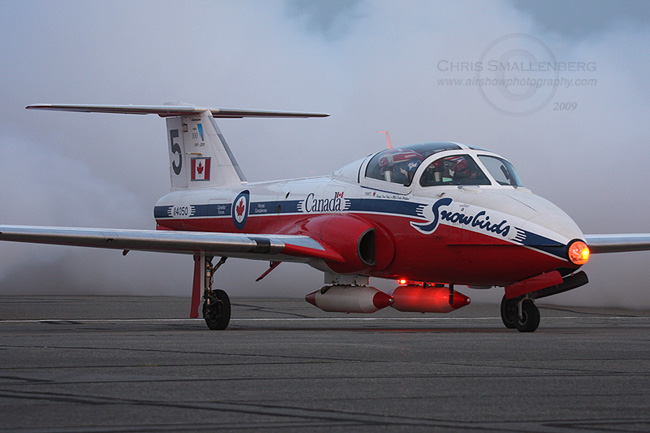
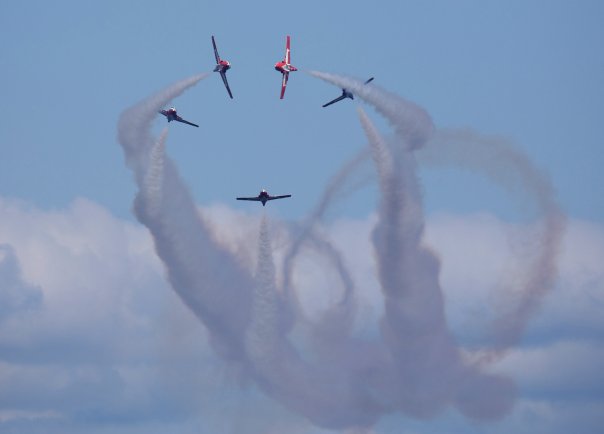

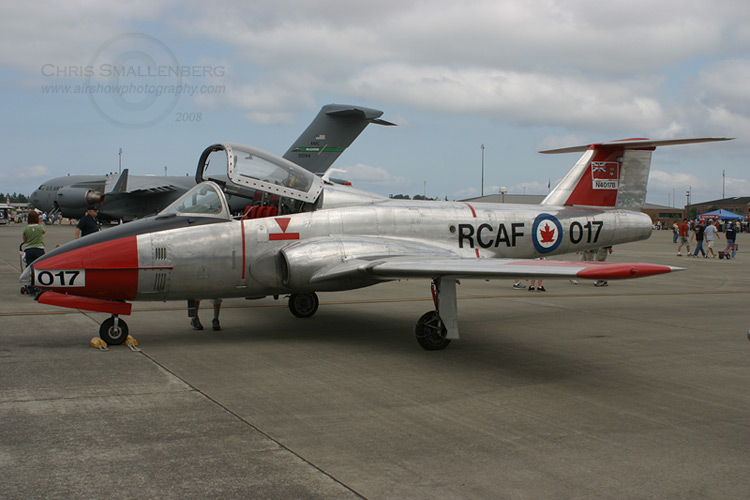
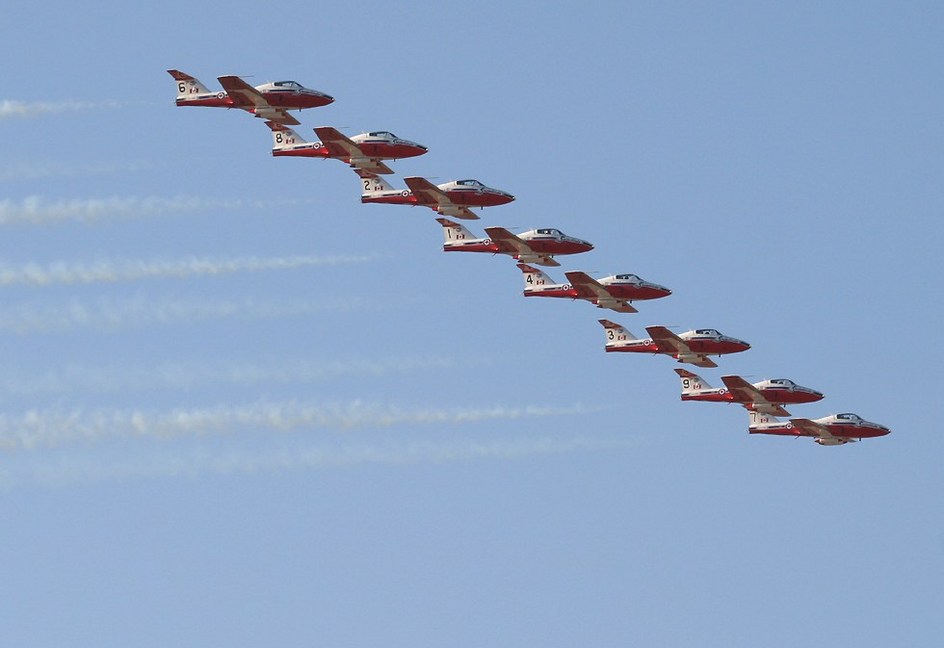
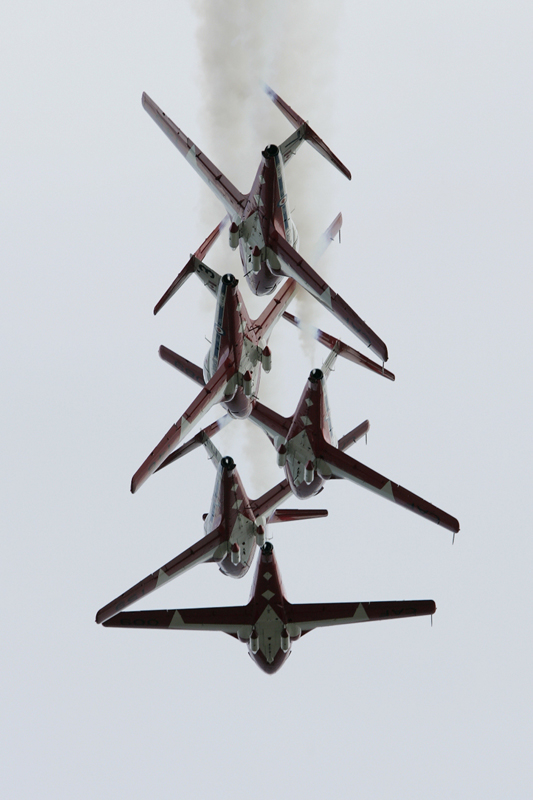
Snowbirds